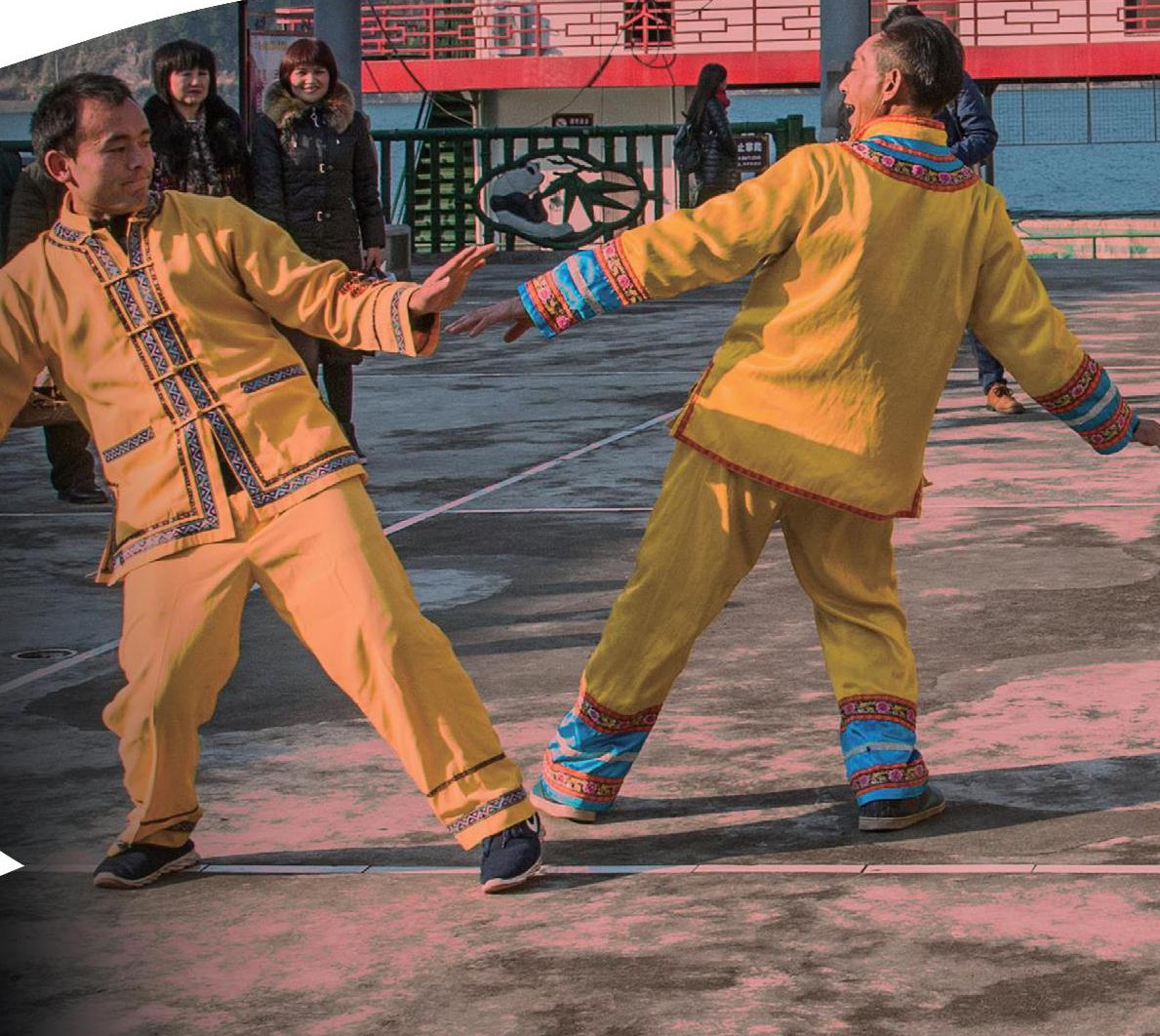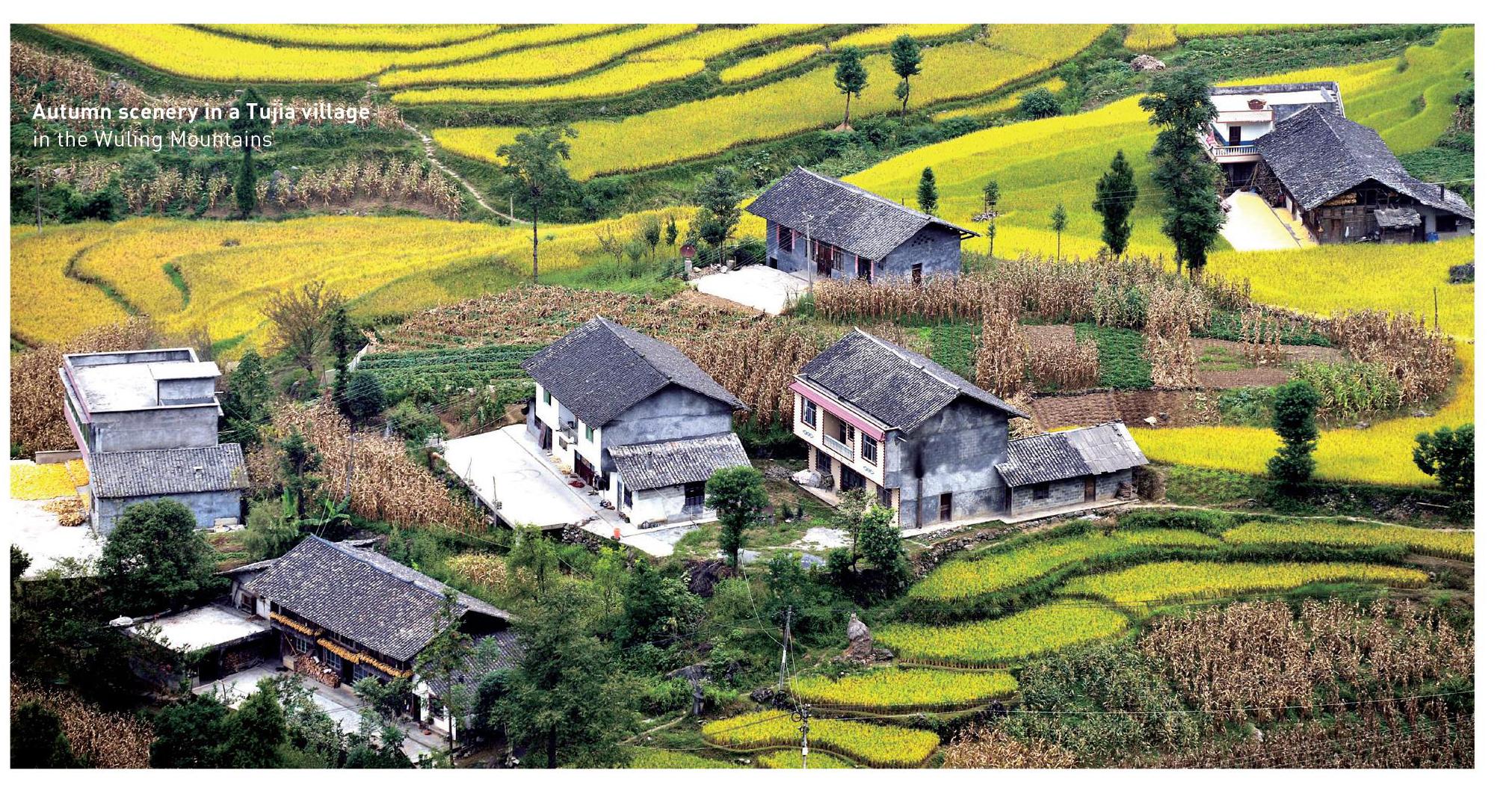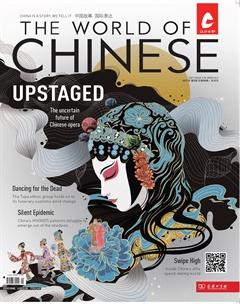Dancing for theDead
BY Mads Vesterager Nielsen



A chance encounter with the Tujia ethnic groups funeral practices in south-central China
传统葬礼上,土家族人载歌载舞,延续着千百年前的圖腾文化和生死观
BY Mads Vesterager Nielsen
They move like ghosts in the night. Techno music infused with cymbals, flutes, and singing in an unfamiliar minority dialect thumps into the highland jungle from a roadside PA system. Through the dusk I can see a procession of white-clad people moving about—the ghosts are waving at me to join in.
At first, the entire spectacle seems bizarre, like a party for spirits. A red truck is parked next to a small house where a stage has been assembled, complete with rotating stage lights, an LED screen, and an aluminum stage frame.
My face is wretched and dirty from a full day of riding a motorbike through the jungles of Chongqing in central China, under the merciless highland sun that causes temperatures upward of 40 degrees Celsius this time of year.
“Please stop and have a rest. We have food for you,” a young man with a white cloth tied around his head tells me. I cant say no to this generous offer. “Later, they will dance for him,” the young man continues.
“Dance for who?” I ask. He points to the LED screen. “For my father.” The screen displays a standard passport-style headshot of a bald man on a red background, and the words “Eternal Affection Musical Memorial Gathering” written over it.
This is a ghost party, all right; just not the kind I had imagined. This is a raucous funeral for the dead.
Mr. Cens last party
“He died from a stroke,” Mr. Cen says of his father, Cen Weigui. As the oldest son, he is the principal mourner of the funeral, as well as the new family patriarch. As he moves through the crowd of attendees, they all direct their grief and condolences to him. “This is the last party we will have with him,” he says.
The Cen family belongs to the Tujia ethnic group. The name literally translates as “earth home” or “local dwellers” in Chinese, implying that these are the aboriginal peoples of the Wuling mountain range that stretch across the central Chinese provinces of Hubei, Guizhou, and Hunan, as well as Chongqing municipality. The Tujias ancestral lands are perhaps most famous for their depiction in the American sci-fi blockbusterAvatar, where the characteristic rock formations of the Zhangjiajie region served as the movies otherworldly backdrop.
The Tujia are the seventh largest ethnic group in China. With a population of about 8.3 million, they just outnumber the Tibetans by around one-and-a-half million. They are closely linked to the Ba kingdom, which was situated in and around present-day Chongqing and the Yangtze River some 3,000 years ago.
The Tujia consider the Ba people their ancestors, and through the ages they have played no small part in Chinese history. In Chinese historical annals, the Tujia have gained fame for two things: dancing and being fierce warriors.
The Ba people were noted to have helped King Wu of Zhou to defeat the Shang dynasty in 1046 BCE. According to theChronicles of Huayang, a local record, “The Ba troops were so brave that their singing and dancing made the frontier troops of the Shang change sides.” These dances were soon widely known as the Bayu dances. The dance of the ancient Tujia gained such renown that Liu Bang, the famed founding emperor of the Han dynasty (206 BCE – 220 CE), made the Bayu the official dance of his court.
According to the Tujia themselves, their great ancestor, Linjun (廩君), changed into a white tiger when he died in order to protect his descendants. This is the origin of the cult of the White Tiger Totem, the Tujia form of ancestor worship. The White Tiger emblem is often carved in temple halls and family shrines as a guardian spirit. Tujia dances, such as the Bayu—which has countless variations—reflect the same symbols; dancers move in rows toward the front, imitating warfare, before they move to the side and are replaced by other warriors moving forward. They also imitate the White Tiger or other spiritual animals.
The strength of Tujia culture lies equally in its ability to absorb ideas and customs from the outside, while maintaining the Tujia language and customs. The Tujia have no written script, so some anthropologists go as far as to suggest that dancing and singing are the Tujias vernacular form of historical annals. In the Qing dynasty (1616 – 1911), Tujia culture became heavily influenced by Han and Buddhist traditions as local leaders were integrated into the imperial bureaucracy. By the 20th century, the Wuling Mountains and the Qingjiang River Valley became a fervent site of western missionary activity, exposing many Tujia to Christianity.
The Tujia still have distinct traditions that linger on into the present, but the majority are fully assimilated into Han society and have adopted customs that mix with their ancestral worship and traditions.
Cen Weigui, the deceased, was a security guard who died on duty, his son informs me while a slideshow of about 10 pictures flick by on repeat projected on a screen behind him. There is a selfie of the elder Cen with his wife, another of him in front of the entrance of the compound he guarded, a vacation picture with Cen Weigui in front of a swimming pool, Cen Weigui with children from his extended family...
As of yet, theres not much that really distinguishes this ceremony from a Han gathering. “What is special about a Tujia funeral?” I ask.
Cen, the son, looks at me and yells through the insistent techno, “The dancing!”
In Chinese historical texts, such as theClassic of the Mountains and Seas, the Tujia have been recorded using dancing to mark significant events—like victories on the battlefield and weddings.
The funeral dance, orSayerhe, however, is regarded as the epitome of Tujia ideal of life, as it serves as a spiritual link to ancestors and the greater Tujia community. If a person over the age of 60 dies, the Tujia see the funeral dance as a positive, even romantic way of celebrating life and bringing peace to the dead. Cen Weigui was 62 when he died.
Historically, there was also a more practical reason for the dancing: The dancing and singing all night beside the coffin could ensure that no wild beasts prey on the body.
Few Tujia cultural traits have survived the centuries of interconnectivity and centralized rule that began under the Ming dynasty (1368 – 1644). There are not many left who speak the Tujia language, and those who do often live in remote mountain villages. The predominant cultural features that survive are the cult of the White Tiger Totem and the ritual dancing, used in all major life events.
“First we will all pay our respects to my father, then we will go eat,” Cen, the son, says. “Afterward, the dance will commence. He will not be alone tonight.”
Funerary melting pot
Although the Tujia have their own funeral customs, I quickly realize the funeral I find myself at is a mix of all kinds of rituals—Han, Daoist, and Tujia.
Chinese funerary traditions vary widely across regions and cultures. Generally it includes a period of mourning, usually between a week and a month, as well as donning costumes symbolizing death. The immediate family of the deceased typically wear white cloth—white being the traditional color of mourning—and walk through the streets with wreaths and a picture of the deceased like a procession of ghosts. The funeral processions are a way to generate a spectacle for the family to show filial piety and respect for the deceased.
The Cen familys funeral is held in the outskirts of the Shizhu Tujia Autonomous County, which is just one mountain range away from the Yangtze River itself. A steep cliff abuts the county, and its clusters of small villages cling to the mountain ridge. Shizhu is not as famous as the river towns along the Yangtze, which are passed by the cruise ships that carry tourists, pendulum-like, between the metropolises of Chongqing and Wuhan, stopping at the Badong Tujia village before setting off to the Three Gorges Dam.
Family members have come from all over China. “I only heard the news two days ago,” one woman, a distant cousin of the deceased, tells me. She has flown all the way from Changchun, in Chinas northeastern Jilin province, just to attend the funeral on this small mountain road in Chongqing. Others have come from nearby Hubei and Hunan provinces, and another guest is from Shanghai. The more people the family treats to a meal during a funeral ceremony, including relatives and neighbors, the greater the filial piety shown to the deceased. As one traditional Tujia song goes: “Family love is greater than the sky; woods have roots, waters have their source, and love should be repaid.”
Above the deceaseds picture, the message of the mourners read: “The venerable Cen Weigui has finished this journey,” followed by four characters on each side of his portrait: “We deeply mourn his passing.”
Gyrating for ghosts
“They are a famous local dance troupe,” Cen, the son, says, nodding toward the dancers who are getting ready on stage. Behind them, an introduction of the dancers emerges on the LED screen: 6 + 1 Dance Center. “They are from an ethnic minority college in Chongqing and I saw them in a talent show on TV.”
The whole scene is chaotic. The dance troupe is performing their routine wearing glittery silver hip-hop costumes lined with black strips, printed with the word “HOLYFUXK” repeated several times. It seems a bit much for a funeral, but nobody seems to care. I recall stories I have read about village funerals in China, where strippers have been hired to attract villagers and beef up numbers at the last party for the deceased. By comparison, this is still within the (wide) boundaries of respectability.
Its a show fit for television, with all the symbols that go with popular culture: microphones, costumes, glitter, and slightly suggestive moves. The dancers retire briefly while the master of ceremonies comes up on stage again. “Please welcome our dancers as they prepare theSayerhe.”
As the four male and female dancers return, they are now dressed in traditional Tujia clothes: blue vests lined with gold, with zig-zag patterns in red and green that run down the middle of the dancers chest. Suddenly, loud music blasts out into the night, with an insistent bass that sounds like a track from a late-night KTV session, and the dance commences.
This is not a traditional Tujia funeral, but that is the reality of many minority families that mix customs while still clinging to their ethnic identity. Here, new musical forms and technology blend with old customs to form the Cen familys modern form of mourning on this night.
As the dancers begin, we all sit and watch. They move in pairs, bending the waist, the knees, the elbows in a zig-zagging movement. They move forward, disperse, and fall back like a formation of warriors, light on their feet, forced to follow the musics bass-laden rhythm and modern beat.
“We attend many funerals,” one of the dancers tells me after the show. “The TV appearance really helped us and Tujia families invite us because we dance theSayerhe.” Whether entirely traditional or not is a matter of individual interpretation at this point, but this group performs a vital service for Tujia communities in the mountains and valleys around Chongqing.
In his bookThe Souls of China, Ian Johnson explains the loud noise in funerals is a way of opening the gates of the spirit world for the deceased. He described a Daoist music group in the Taihang Mountains who travelled from funeral to funeral to perform this ritual act. On this night, there are no folk musicians and no religious master scrutinizing the minutiae of tradition. Instead, there are young Tujia students equally adept at gyrating to KTV and dancing for ghosts.
“You can go pay your respects to my father now,” Cen, the son, says.
I walk into the small chamber. Ashes from sacrificial burnings of paper are scattered on the ground. I place my knees on a yellow cushion in front of Cen Weiguis portrait and kneel three times before I exit.
As the PA is turned off and the dancers pack up their belongings, a solemn quiet settles over the house beside the mountain road. Like the feeling after a rock concert, an all-encompassing and persistent sound of silence fills the space left by the absence of deafening music.
“Enshi,” I say to Cen the younger. “My condolences.” He bows his head. “Thank you.”
That night, with the help of neighbors, relatives from across China, a dance troupe from TV, and one foreign spectator, the gates were opened in the summer night for Cen Weiguis ghost to proceed to the afterlife.
Autumn scenery in a Tujia village in the Wuling Mountains
Bronze weapons of the ancient Ba kingdom on display in the Chongqing Museum
A White Tiger emblem on the front wall of Linjun Temple in Enshi, Hubei province
Sayerhewas traditionally danced by men, but the ritual later evolved to include female dancers and drummers
Villagers from Sanlicheng, Badong county put on an emotionalSayerhedance
The Tujia folk band Sayerhe performs in Hubei province
Photographs by VCG and Fotoe
Photographs by VCG
 汉语世界(The World of Chinese)2021年5期
汉语世界(The World of Chinese)2021年5期
- 汉语世界(The World of Chinese)的其它文章
- China’s Other Vaccine Drive
- 三味书屋
- The Changing Face of YinggeDance
- Upstaged
- SilentEpidemic
- 学中文
